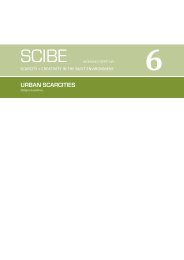SOME THOUGHTS ABOUT SCARCITY - SCIBE
SOME THOUGHTS ABOUT SCARCITY - SCIBE
SOME THOUGHTS ABOUT SCARCITY - SCIBE
Create successful ePaper yourself
Turn your PDF publications into a flip-book with our unique Google optimized e-Paper software.
10<br />
Edward Robbins<br />
developments, have a very different spatial order than the more formal city<br />
of which they are a part. Their street structure, their densities, the way they<br />
connect to the rest of the city through their structure of streets, their<br />
physical accessibility for cars, buses and trucks and their often lack of any<br />
orthogonal logic contrast considerably what we have come to see as the<br />
conventional urban structure that surrounds them. 3 And again the variety<br />
of slum spatial forms as with housing present us with challenges that are<br />
not different only in detail but are poles apart in regard to the larger social<br />
and political issues they raise and the design strategies needed to address<br />
them.<br />
For example, one might well argue that to respond to a condition like<br />
that imposed by a slum like Kibera with high rise or middle class housing -<br />
often the result of what is seen as creative urban upgrading - no matter<br />
formally or aesthetically pleasing or inventive is not particularly creative as<br />
it does not address the issues Kibera poses for those who live there. Indeed<br />
self built mud shacks that engage with the conditions found in Kibera may<br />
be more creative to the extent that the designs address issues of disease,<br />
comfort, cleanliness but in conceivably unaesthetic and conventional forms.<br />
It depends on what is seen as scarce – new and inventive house types or<br />
housing serves the most people in a reasonably affordable and salubrious<br />
manner. You can take you choice. The key though is that it is a choice – it is<br />
never obvious because how we measure scarcity is never obvious.<br />
In much of Northern Europe we often find social housing from the<br />
1930’s compared to contemporary housing. Usually, the housing from the<br />
1930’s is seen as of higher quality and a more creative solution to the<br />
challenges posed by the dearth of affordable housing in either period. We<br />
need to ask though whether these two periods are comparable. In the first<br />
instance scarcity was seen as a social challenge and the result of larger<br />
social forces – housing was seen as a social good and more often than not<br />
3<br />
Some argue that this new slum morphology has major lessons for city building and spatial<br />
design.




